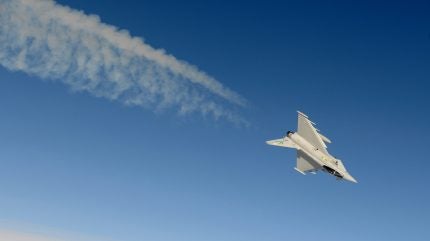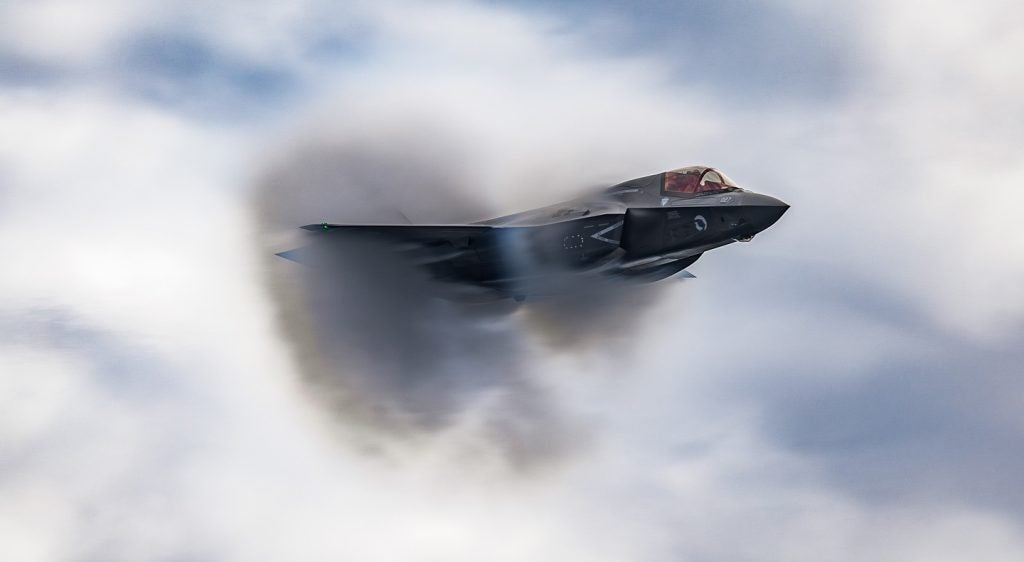
The prospect of a UK acquisition of more F-35 stealth fighters in favour of Eurofighter Typhoons continues to hold the attention of defence observers, and while military capabilities are being analysed, another important factor to consider is the potential impact to the defence aerospace sector.
Published on 31 March, The Times reported that the UK would move to buy additional F-35 fighters, instead of new Eurofighter Typhoons. Influential UK union Unite has previously called for the UK to invest in the Eurofighter programme, citing concerns over jobs.
Unite followed up with a stinging criticism of any potential UK purchase over the F-35, as reported by Airforce Technology.
As it happens, UK defence prime BAE Systems is heavily involved in both the F-35 and Eurofighter programmes, with sizeable percentages of each aircraft manufactured in the North West of the country at the company’s Samlesbury and Warton sites respectively.
BAE claims 15% of each US-designed F-35, the most expensive defence programme in history, is built in the UK, including all aft fuselages, while horizontal and vertical tails and components are also manufactured at facilities in the UK and Australia.
The company also states that it delivers key electronic systems onboard the fighter, including the electronic warfare suite, vehicle management computer and Active Inceptor System.

US Tariffs are shifting - will you react or anticipate?
Don’t let policy changes catch you off guard. Stay proactive with real-time data and expert analysis.
By GlobalData
BAE Systems says that it employs more than 2,300 people in support of the F-35 programme globally, including 1,500 manufacturing specialists at Samlesbury in the North West of England.
Meanwhile, Unite estimates that around 6,500 jobs at BAE Systems and at engine supplier Rolls Royce are directly dependant on work on the Eurofighter Typhoon, with a further 14,000 in the supply chain. Around half of the jobs are in the North West of the country.
The UK has a workshare of the Eurofighter programme of around 37%, as it intended to be the single largest operator of the platform, although this status has since been lost to Germany.
However, the US alone is looking to acquire around 2,500 F-35s across all three variants, with hundreds more contracted to overseas buyers. For the Eurofighter, Airbus reported in March 2025 that the current programme of record was 721 aircraft, with 609 delivered.
The UK government has been keen to talk up the prospect of increased military spending providing a benefit to the country’s defence industry, and will have to balance pros and cons on both sides.
UK switching from B to the A variant?
With one of the two Queen Elizabeth class aircraft carriers increasingly likely to be mothballed in the Strategic Defence Review due to publish this Spring, the need for the naval-capable STOVL F-35B variants will reduce. If the Royal Navy will only ever operate a single carrier, then having more than the 48 F-35Bs contracted is unnecessary.
The RAF would prefer the conventional F-35A variant, which cannot be operated from aircraft carriers and functions more as a traditional combat air platform. It has greater payload and range compared to the B model.
According to a 28 March UK parliamentary response by UK Defence Procurement Minister Maria Eagle, the purchase price of an F-35A is estimated to be 15% less than the cost of an F-35B. The running cost of an F-35A is estimated to be 8% less than an F-35B.
However, the kinematics and intercept capabilities of the rival Eurofighter, particularly the later Tranche 4 and Tranche 5 models, exceed the F-35. In UK service, the Eurofighter is used as the Quick Reaction Alert force, with two squadrons available for immediate launch at RAF Lossiemouth and RAF Coningsby.
In the QRA role, stealth would not be required, rather the ability to rapidly climb to intercept Russian bombers and other airborne threats. The Eurofighter is thought to have a superior climb rate compared to the F-35, particularly at mid-to-high altitudes, and is faster, reaching a maximum speed of around Mach 2, compared to the F-35A’s Mach 1.6.
The F-35A, by contrast, is a ‘Day 1-capable’ platform, meaning it can operate inside contested airspace at the outset of a warfighting scenario, utilising its advanced electronic warfare and stealth capabilities to make enemy detection extremely complex.
Is the F-35 compromised?
There has previously been concerns that the F-35s design could be compromised, with suppliers linked to China having earlier been used in the programme. Most notably, this included China-owned UK company Exception PCB, which provided circuit boards for the international F-35 programme.
Chinese hackers have also been reported to have stolen huge amounts of data of the F-35 and earlier F-22, which has been utilised into Beijing’s own stealth fighter programmes such as the FC-31 and J-35.
In addition, the on-off potential for Türkiye to be readmitted into the F-35 progamme also poses security threats, with Ankara operating the Russian S-400 air defence system. Türkiye was previously kicked out of the F-35 programme by the US for its acquisition of the S-400, with US official fearing that stealth and targetting data could find their way to Moscow.
However, with the bizarre situation that Washington finds itself increasingly allied to Moscow and abandoning its security relationship with Europe, even going to far as to threaten the annexation of Greenland – an autonomous territory of Nato member Denmark – the White House may no longer have concerns over the sharing of such information.
F-35 vs Eurofighter: international consequences
Europe will be furious, particularly new best friend Germany, which through its interests in Airbus is seeking a UK purchase of Eurofighters in order to keep the programme viable for all partners, including Spain and Italy, through to 2040.
While BAE Systems works in both F-35 and Eurofighter programmes, and is the lead industry partner in the sixth-generation Global Combat Air Platform (GCAP) between the UK, Italy, and Japan, unions have previously raised concerns over the impact in opting for more F-35s over the Eurofighter.
However, given the nature of the three defence aerospace programmes (F-35s, Eurofighter, and GCAP), a degree of consolidation from one to the other could be required if the delivery timelines of GCAPs entry into UK service by 2035 is to be met. This corresponds with the planned removal of the remaining Tranche 3 Eurofighters in UK service.
It has always been the UK’s concept of airborne operations to maintain a mixed fleet of fifth-generation F-35s and sixth-generation GCAP fighters from the late 2030s onwards, a natural evolution of the current fourth-generation Eurofighter and stealth F-35Bs.
However, any such decision to favour the US over Europe will likely be noted for future European programmes, particularly those being undertaken within the ReArm Europe initiative.
Conversely, a Trump-led administration in Washington would take a dim view, to put it mildly, of a UK move towards acquiring additional Typhoons.



